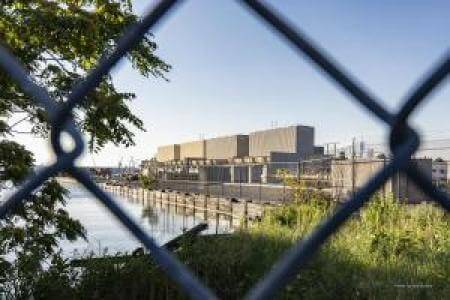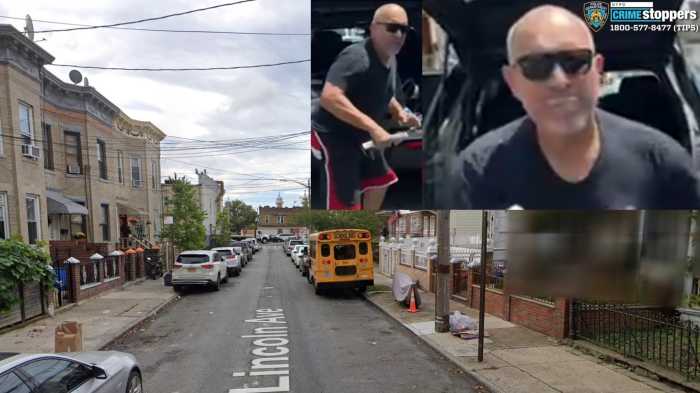More than 40 city and state elected officials signed onto a letter on Thursday calling on Gov. Kathy Hochul to deny permits for the Gowanus Repowering Project.
Among the signatories were borough president and likely future mayor Eric Adams, city council members Brad Lander, Antonio Reynoso, and Stephen Levin, and assembly members Jo Anne Simon and Marcela Mitanyes.
“The Gowanus fracked gas plant is an affront to environmental justice, threatening the health of the communities of color in which it is located,” the letter reads. “It would undermine the aggressive renewable energy goals contained in New York’s new climate law.”
The Gowanus Gas Turbine Facility is one of three “peaker plants” operated by the Astoria Generating Company in New York City. Two of the plants, the Gowanus Generating Station and the Narrows Generating Station, are floating on barges in Brooklyn.
The Gowanus facility, located on four barges in the Gowanus Bay near Sunset Park, is one of the largest floating power stations worldwide, according to Eastern Generation, AGC’s parent company.
Both are “peaker” plants, meaning they operate only when electrical use is at its highest in the city – usually on particularly hot summer days when air conditioners are cranked to their highest settings. According to a 2019 report by the PEAK Coalition, the Gowanus plant ran for a total of about 30 hours in 2018, and emits more than 19,000 tons of carbon dioxide annually.
The facilities, both opened by ConEdison in the early 1970s, were expected to close by 2025 to comply with new state emissions regulations. But in 2019 AGC proposed the repowering project, which would replace 32 old combustion units in Gowanus with eight new natural-gas powered units on two barges. The company plans to retire the Narrows plant if and when the repowering project is completed.
“We need dramatically more ambitious action on climate,” Lander said at a press conference Thursday. “We need a much quicker transition from moving gas and other fossil fuels to clean energy, clean electricity.”
He compared it to legislation in the city council that would prevent new buildings from connecting to gas lines. Older buildings will still need to be converted to clean energy eventually, he said, but new buildings are a good place to start.
“This is similar. We are going to need to take down existing gas plants and convert them to clean renewable power, to wind, to solar, and other renewables,” he said. “But what an obvious place to start not to repower fracked gas plants that have reached the end of their useful life. This is like building a new fracked gas plant, and we cannot allow it.”
Both Brooklyn plants are adjacent to Sunset Park, designated an environmental justice area by city law. These communities “have been and continue to be more vulnerable to potential environmental injustices due to factors including history of systemic racism and inequitable resource distribution,” according to the Mayor’s Office of Climate and Sustainability.
“For years, we’ve been suffering,” said Assemblywoman Marcela Mitanyes, who represents the neighborhood. “Redlining pushed us to the outskirts. We’re living in flood zones and transit deserts. There’s a highway that cuts through the community, polluting the very air we breathe each and every day.”
The community has been treated as a “dumping ground,” she said, being polluted and ignored.
“We must play a key role in protecting our community and ensuring we have a sustainable future by committing to the most aggressive climate agenda,” she said. “As government we must commit to ensuring we are putting people before profit.”
Jeff Lowell, Adams’ policy director, said the beep is committed to climate resiliency and reducing the city’s reliance on fossil fuels, and opposes the project.
“Gowanus and other coastal communities have also felt severe effects of climate change,” Lowell said. “Our use of fossil fuels should not be.”
In their scoping report, AGC said that the repowered plant would reduce emissions even if the plant is run more often, and that retiring the Narrows plant would further cut down pollution.
In 2019, the state’s public service commission approved a plan to construct a battery-storage facility at the Ravenswood Generating Station in Queens. The facility would store energy generated during off-peak hours, then route that energy back onto the grid during peak times, rather than actively generating the needed energy like peaker plants do. Part of the storage facility was supposed to be operational by last spring, but construction has been delayed.
Last year, the New York Power Authority announced they’d be working alongside the PEAK Coalition to explore clean energy options for the six peaker plants they operate in New York City and on Long Island
AGC has submitted a preliminary scoping statement and a public involvement plan but have not yet sent in a final application.
“It’s unclear on when they’re going to do so,” said Patrick Houston, a campaign associate with New York Communities for Change. “They’ve had the opportunity to do so for the last few months, and they have not. But they could any day now, or any week, or any month.”
Once an application is sent in, the state’s board on electric generation siting has 60 days to decide whether or not the application is complete and set a date for a public hearing. The board must make a decision 12 months after the application is approved.
“We have been in other fossil fuel infrastructure fights where we advocate too late, and it gets built,” said Santosh Nandabalan, an organizer with Food and Water Watch. “The reason for doing this early in the application is to set the standard that we don’t want any fossil fuel infrastructure, including the Gowanus fracked gas plant.”





































